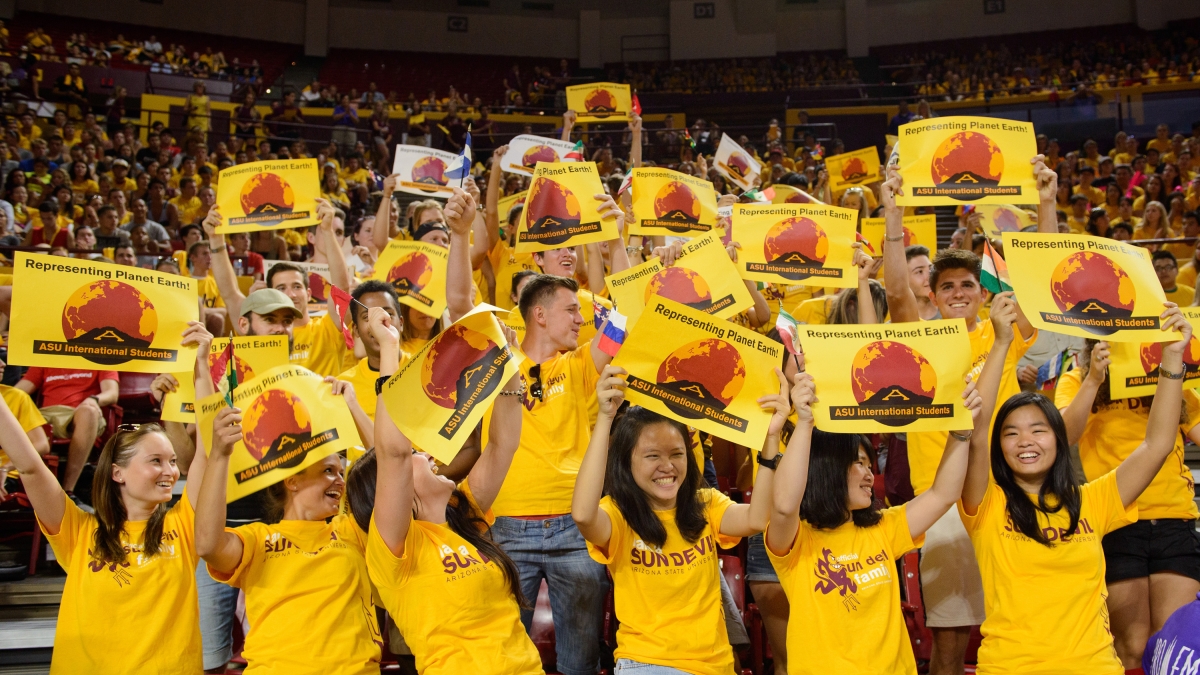ASU freshman class breaks records for enrollment, diversity, honors students

Class includes nearly 10,700 academically distinguished Sun Devils from 50 states and 63 countries
Arizona State University is welcoming an academically strong and remarkably diverse freshman class that includes many students who have distinguished themselves both inside and outside the classroom.
The new class of Sun Devils rises from the largest pool of freshman applicants in the university’s history, and among its ranks are a 16-year-old with four associate’s degrees, a retired Marine Corps sergeant, a first-generation college student from the top of her high school class, and twin sisters who perform with the Thailand Youth Orchestra.
“The more than 46,000 applications we received from aspiring freshman is a testament to ASU’s reputation as a premier university, and the quality of the students who are joining our community of higher learning signals great things for ASU’s future,” said Provost Robert Page.
The number of students applying for admission as first-time freshmen represented a 25 percent increase over the previous academic year. The 10,635 who are enrolled represent an academically strong group, with an average high school GPA of 3.4 and an average SAT score of 1113. More than half, 54 percent, are New American University Scholars at the Dean, Provost and President Scholarship levels, the most prestigious scholarships for first-time freshmen.
Kevin Davies, from Kingman, Arizona, is a College of Liberal Arts and Sciences Dean’s Scholar. A sergeant in the Marine Corp infantry who served in the Middle East and Asia, he is a psychology major who has his sights set on being a doctor.
Davies said he is looking forward to “being around people again and challenging myself in a different way.”
Among this year's class are 6,236 Arizona residents, 62 percent of whom graduated in the top 25 percent of their high school class. Barrett, the Honors College, celebrates a new record of 1,647 high-achieving students. The majority – 1,206 – are Arizona residents.
Among these honors students is 16-year-old Alexander (AJ) Gilman from Paradise Valley, Arizona. A business and legal studies major in the W. P. Carey School of Business, he enters ASU with 111 college credits and associate’s degrees in business, arts, science and general studies. He comes from a Sun Devil family, and his mom has an accounting degree from W. P. Carey and a law degree from the Sandra Day O’Connor College of Law.
Hoping to follow in his mother’s foot steps, with his eyes set on law school, Gilman chose Barrett “because it offered an individualized experience and a feeling of community,” which is important to him.
ASU continues to honor its longstanding commitment to socioeconomic diversity and access to education with more than 42 percent of enrolled Arizona residents reporting they will be the first in their family to go to a four-year college, and 39 percent coming from low-income families.
Sarah Rutkowski, from Chandler, Arizona, is a first-generation college student who was awarded an APS scholarship. Also a first-generation immigrant whose parents came from Poland, Rutkowski overcame a challenging childhood and graduated in the top 4 percent of her class from Corona High School.
A record number of non-resident students have also made ASU their school of choice. 4,399 students representing all 50 states and 63 countries are members of this year’s class, with the largest number – 1,173 – coming from California. ASU has increasingly becoming a school of choice for students from the Golden State.
Collectively, this year’s freshmen make up ASU's most diverse class to date, in terms of their racial and ethnic backgrounds – 39.4 percent of the class.
Xochil Rina Goretsky, a Yaqui-Chicano-Jewish American from Mendocino, California, is a Barrett Honors student majoring in public health at the College of Health Solutions on the Downtown Phoenix campus. Her path to college has been a personal challenge after suffering a severe concussion in junior high school. She had to re-learn how to read, among other things, and said what kept her going was a desire to change the world.
After being accepted to ASU, the University of Arizona and Drexel University, she chose ASU. “I felt ASU said, ‘We believe in you and are willing to invest in you because we know you are going to put in 110 percent,'” said Goretsky. “I want to explore, and I think this is the place to do it.”
More international students will call ASU and the Phoenix-area home than ever before, with more than 900 new freshmen hailing from outside of the United States. ASU has set the record for the number of new international students in the last several years, in part a reflection of the institution’s recognition as a top 100 university in the world by both the Center for World University Rankings and the Academic Ranking of World Universities.
Twin sisters Rittika and Ruchika Gambhir made a long journey from Bangkok, Thailand, to attend ASU, and it was their only choice, due to the “dedicated faculty, diversity of culture and amazing atmosphere.” Both students in the Herberger Institute of Design and the Arts, Ruchika is a double major in oboe performance and music education, and Rittika is a double major in bassoon and music education. Their goal is to become professional musicians working in a symphony orchestra in the U.S.
Many incoming freshmen have selected ASU due to the variety of academic environments it provides students across its five Arizona locations. This year, the university is seeing record growth of students seeking a small college experience with big university resources on the West campus, with 385 new freshmen; Polytechnic campus, with 579 new freshmen; and ASU Colleges at Lake Havasu City, with 33 new freshmen.
ASU is also seeing a continued expansion of student interest in journalism, nursing/health care and public programs at the distinctively positioned Downtown Phoenix campus, with 1,318 new freshmen. The remaining 8,320 members of the incoming class are beginning their college careers at the Tempe campus.